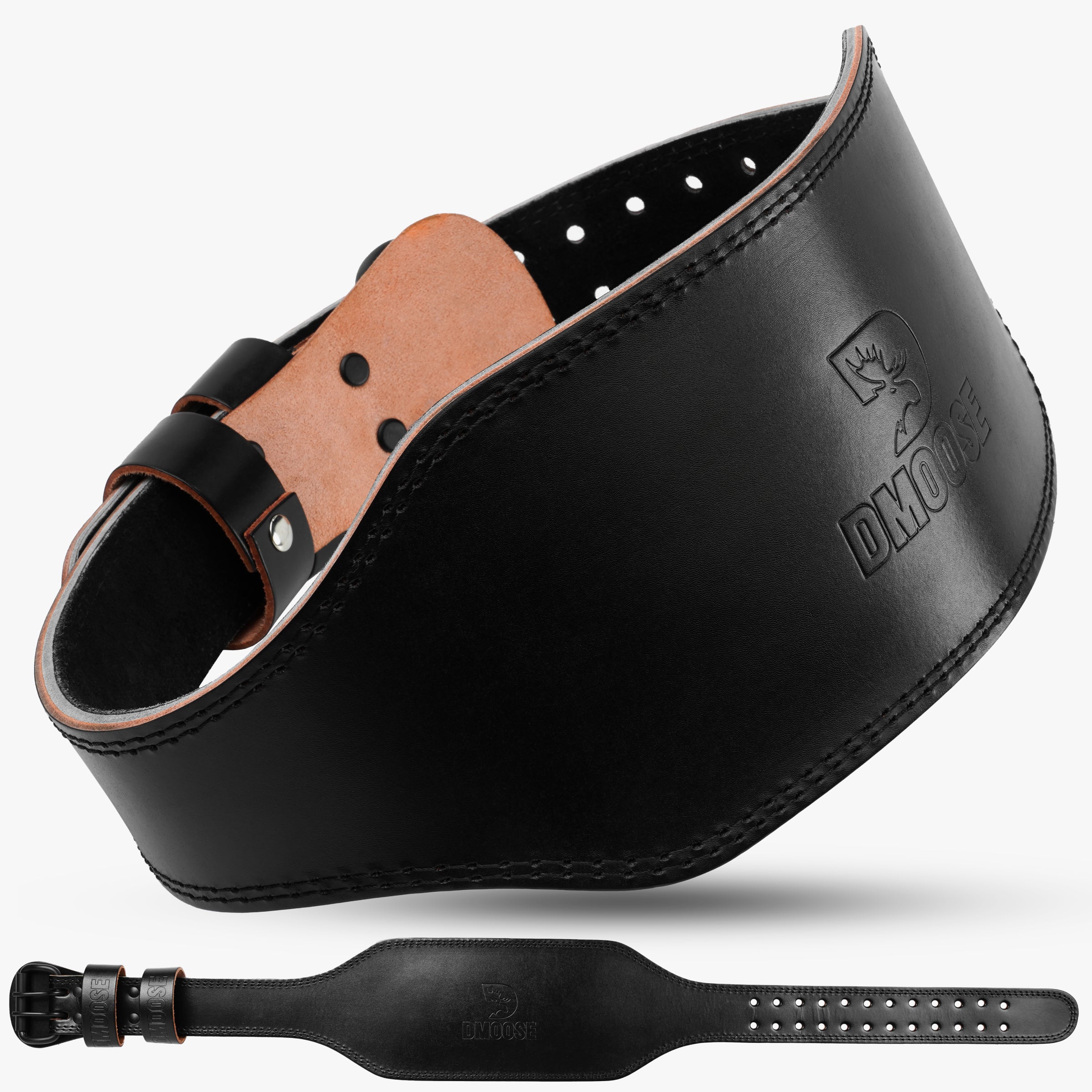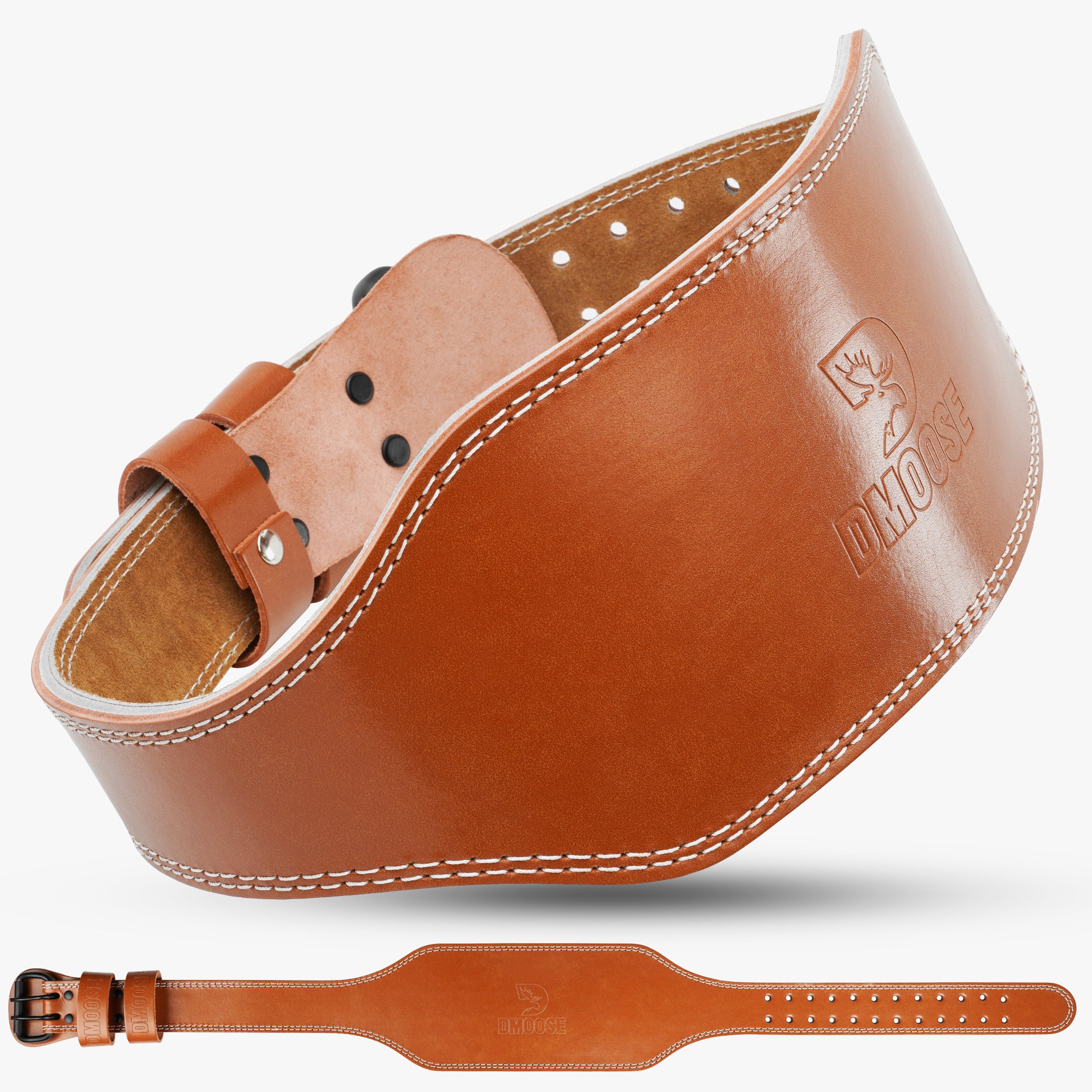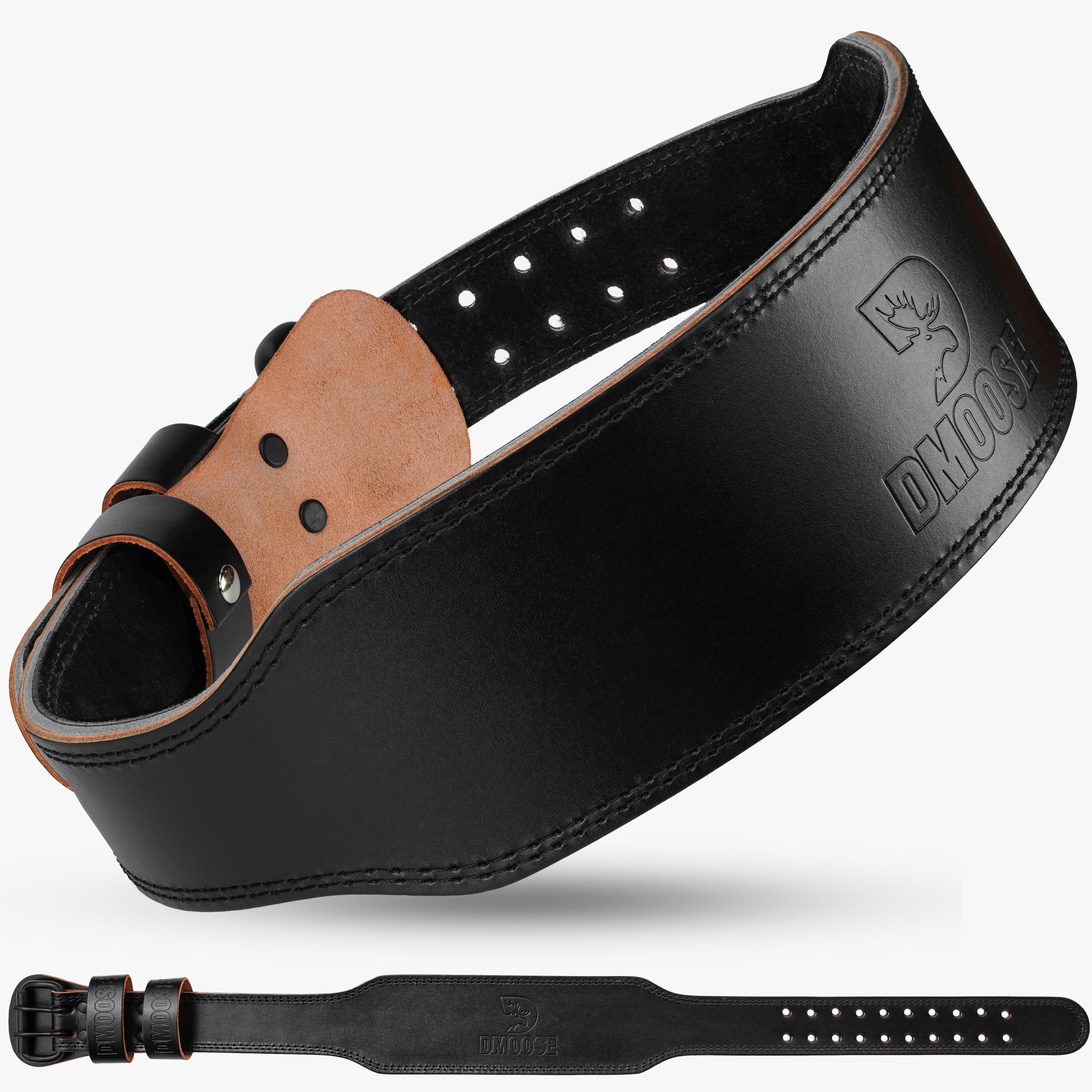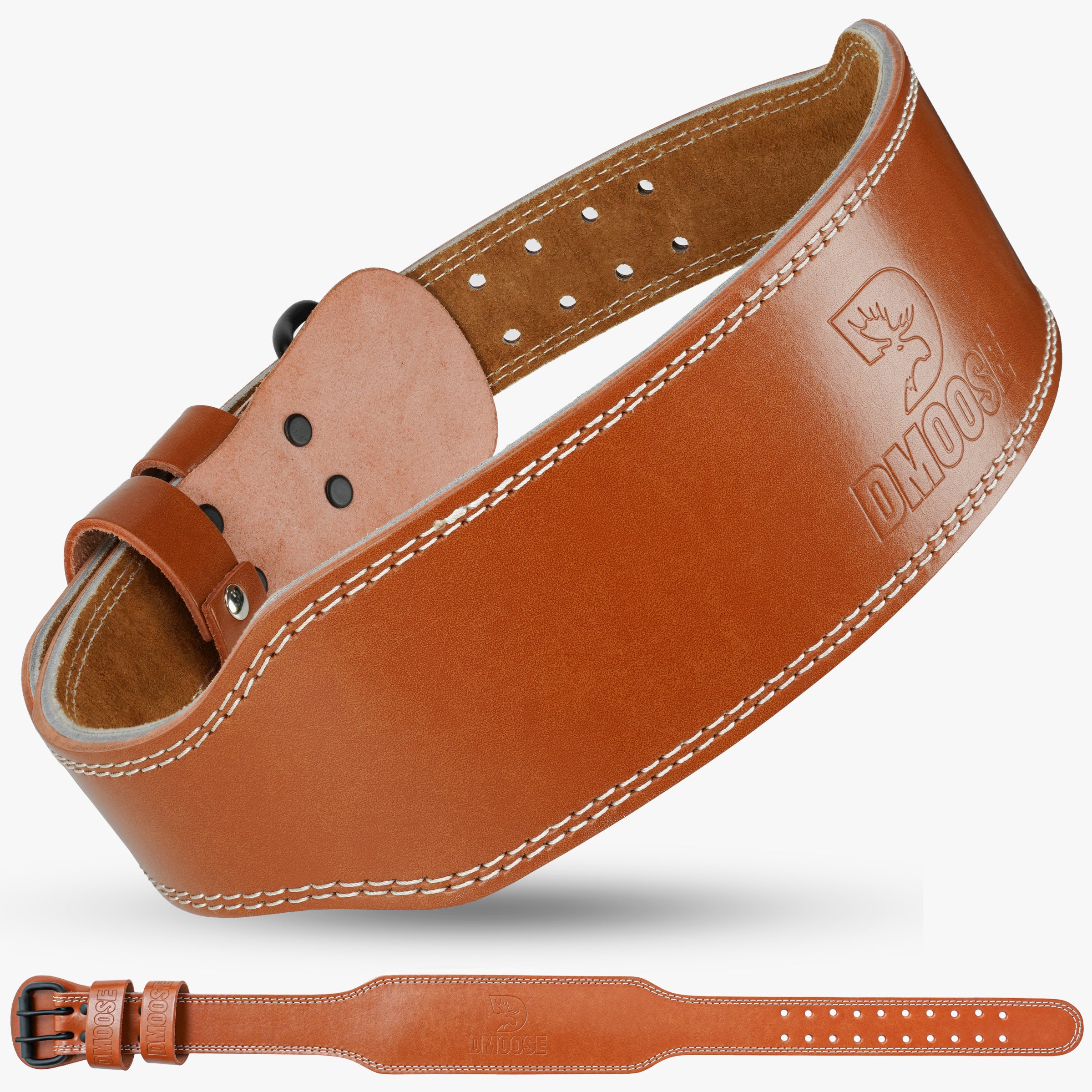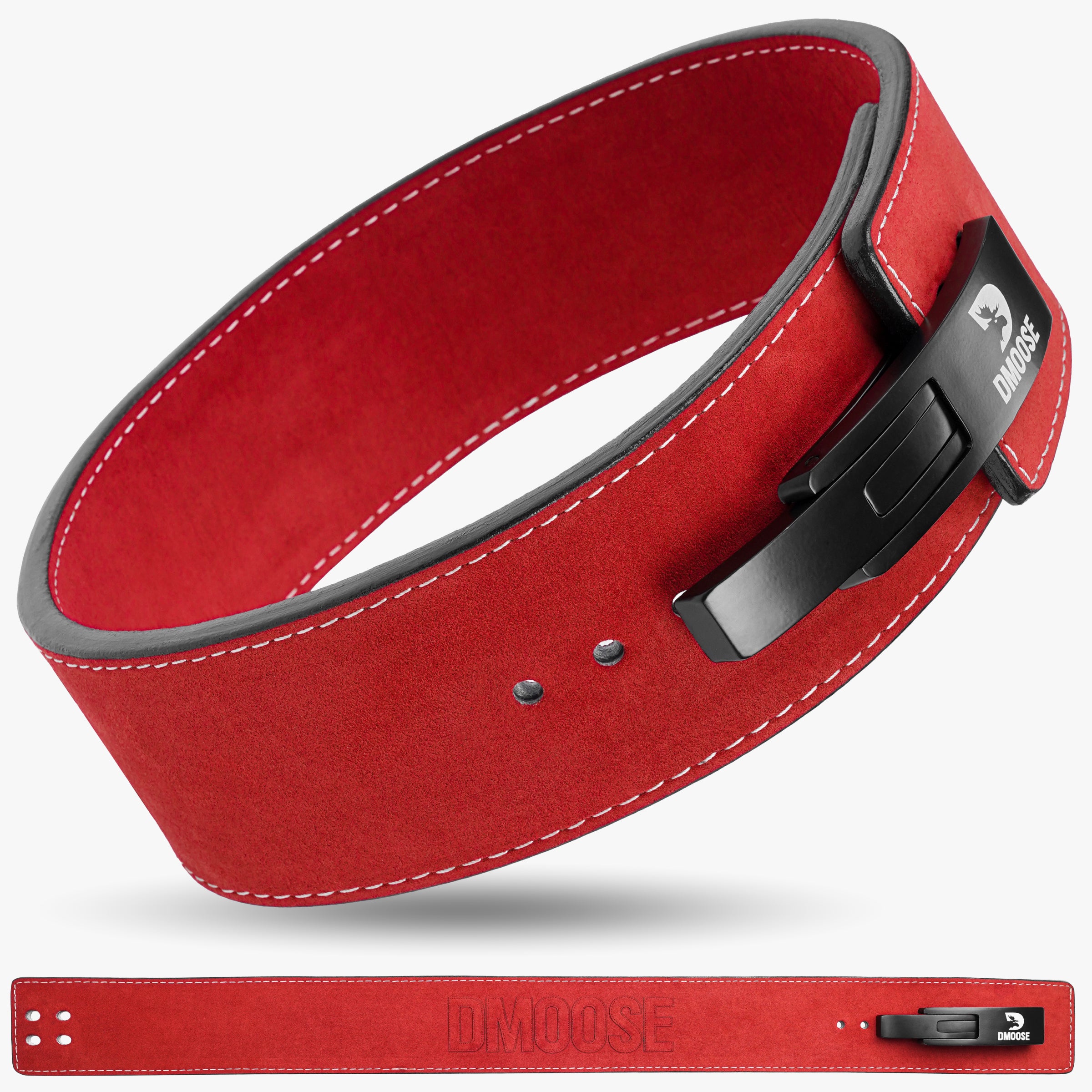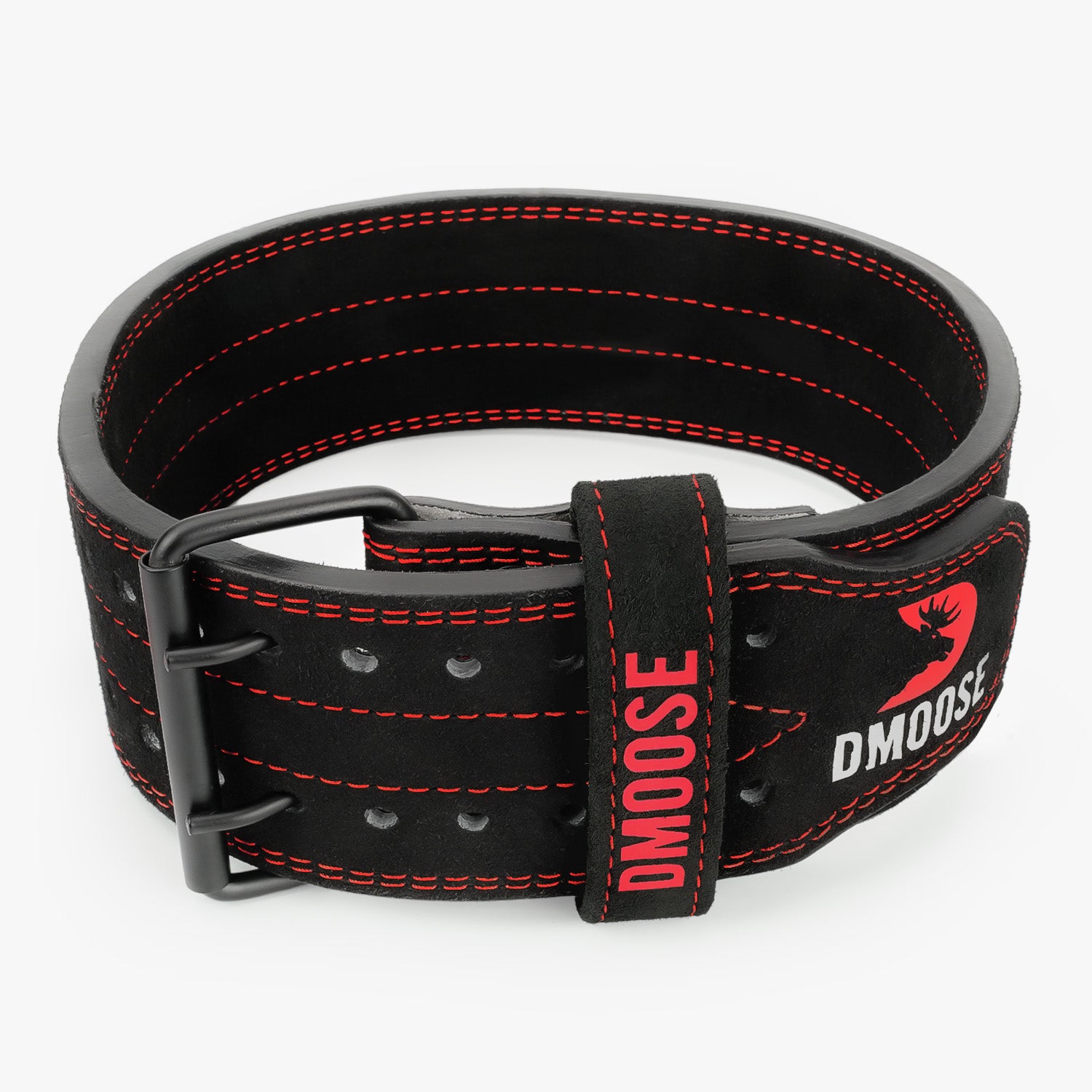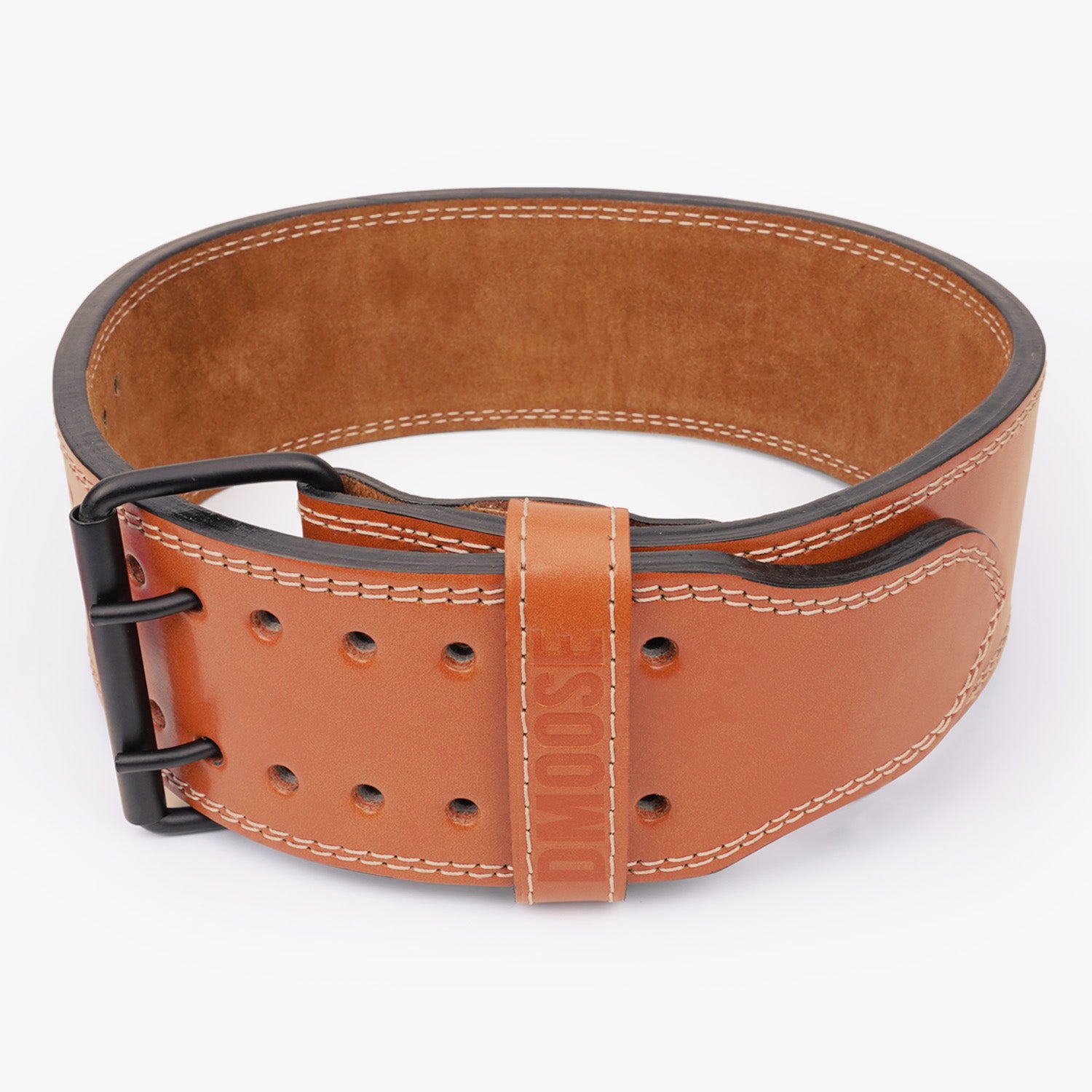-
Rated 4.7 out of 5 stars4.7 Stars (419 Reviews)
Neoprene Weightlifting Belt - Black
Take your strength training to the next level with the DMoose Neoprene Weightlifting Belt, crafted for lifters seeking reliable reinforcement and control. The belt features a contoured design that aligns with your body’s natural curvature, ensuring a secure fit during squats, deadlifts, and other heavy lifts.
With a 6-inch-wide panel and integrated reinforcement ribs, this belt promotes a firm and steady lifting posture. The durable hook-and-loop closure system allows for an adjustable, stay-in-place fit, so you can focus on your performance without distractions.
Made from premium neoprene and nylon, the belt provides a balance of flexibility and structure, ensuring long-lasting durability. Whether you're just starting your fitness journey or pushing for a new personal best, the DMoose Neoprene Weightlifting Belt is designed to keep up with your training needs.
Regular price $35Sale price $35 Regular priceUnit price per$39Ways to save10% OFF -
Rated 4.7 out of 5 stars4.7 Stars (419 Reviews)
Neoprene Weightlifting Belt - American
Take your strength training to the next level with the DMoose Neoprene Weightlifting Belt, crafted for lifters seeking reliable reinforcement and control. The belt features a contoured design that aligns with your body’s natural curvature, ensuring a secure fit during squats, deadlifts, and other heavy lifts.
With a 6-inch-wide panel and integrated reinforcement ribs, this belt promotes a firm and steady lifting posture. The durable hook-and-loop closure system allows for an adjustable, stay-in-place fit, so you can focus on your performance without distractions.
Made from premium neoprene and nylon, the belt provides a balance of flexibility and structure, ensuring long-lasting durability. Whether you're just starting your fitness journey or pushing for a new personal best, the DMoose Neoprene Weightlifting Belt is designed to keep up with your training needs.
Regular price $35Sale price $35 Regular priceUnit price per$39Ways to save10% OFF -
Rated 4.7 out of 5 stars4.7 Stars (419 Reviews)
Neoprene Weightlifting Belt - Green
Take your strength training to the next level with the DMoose Neoprene Weightlifting Belt, crafted for lifters seeking reliable reinforcement and control. The belt features a contoured design that aligns with your body’s natural curvature, ensuring a secure fit during squats, deadlifts, and other heavy lifts.
With a 6-inch-wide panel and integrated reinforcement ribs, this belt promotes a firm and steady lifting posture. The durable hook-and-loop closure system allows for an adjustable, stay-in-place fit, so you can focus on your performance without distractions.
Made from premium neoprene and nylon, the belt provides a balance of flexibility and structure, ensuring long-lasting durability. Whether you're just starting your fitness journey or pushing for a new personal best, the DMoose Neoprene Weightlifting Belt is designed to keep up with your training needs.
Regular price $35Sale price $35 Regular priceUnit price per$39Ways to save10% OFF -
Rated 4.6 out of 5 stars4.6 Stars (202 Reviews)
6" Leather Weightlifting Belt - Black
Achieve the support and stability you need during heavy lifts with the DMoose Leather Weightlifting Belt. It is designed for athletes, weightlifters, and fitness enthusiasts who demand durability and performance.
Made from premium cowhide leather with a 4-inch reinforced back panel, this belt offers a secure and comfortable fit. The double-pronged anti-rust buckle ensures a locked-in feel, while double stitching and sturdy rivets enhance durability, making it a reliable choice for intense workouts.
Whether you're pushing for new personal records, looking for extra core control, or seeking more comfort during heavy lifts, the DMoose Leather Weightlifting Belt is built to support your goals.
Train harder, lift with confidence, and experience premium support with a belt designed for dedicated lifters.
Regular price $39Sale price $39 Regular priceUnit price per$69Ways to save43% OFF -
Rated 4.6 out of 5 stars4.6 Stars (202 Reviews)
6" Leather Weightlifting Belt - Brown
Achieve the support and stability you need during heavy lifts with the DMoose Leather Weightlifting Belt. It is designed for athletes, weightlifters, and fitness enthusiasts who demand durability and performance.
Made from premium cowhide leather with a 4-inch reinforced back panel, this belt offers a secure and comfortable fit. The double-pronged anti-rust buckle ensures a locked-in feel, while double stitching and sturdy rivets enhance durability, making it a reliable choice for intense workouts.
Whether you're pushing for new personal records, looking for extra core control, or seeking more comfort during heavy lifts, the DMoose Leather Weightlifting Belt is built to support your goals.
Train harder, lift with confidence, and experience premium support with a belt designed for dedicated lifters.
Regular price $39Sale price $39 Regular priceUnit price per$69Ways to save43% OFF -
Rated 4.7 out of 5 stars4.7 Stars (1,723 Reviews)
Dip Belt for Weightlifting, Dips & Pull-Ups - Black
Elevate and revolutionize your fitness journey with the DMoose weight belt with chain. This top-tier weighted belt with chain is the ultimate tool for pull-ups, weightlifting, and dips, solidifying its position as the best dip belt available. Experience ultimate comfort with 6-inch lumbar support and a heavy-duty 36-inch stainless steel chain.
Witness your full workout potential with a perfect blend of comfort, durability, and versatility, all packaged into one premium fitness accessory. Securely attach weights with the coated D-ring and enjoy enhanced durability with strong reinforced stitching, tested to withstand up to 350 lbs. Say goodbye to limitations and hello to extraordinary workouts with the DMoose dip belt.Regular price $36Sale price $36 Regular priceUnit price per$54Ways to save33% OFF -
Rated 4.7 out of 5 stars4.7 Stars (1,723 Reviews)
Dip Belt for Weightlifting, Dips & Pull-Ups - Blue
Elevate and revolutionize your fitness journey with the DMoose weight belt with chain. This top-tier weighted belt with chain is the ultimate tool for pull-ups, weightlifting, and dips, solidifying its position as the best dip belt available. Experience ultimate comfort with 6-inch lumbar support and a heavy-duty 36-inch stainless steel chain.
Witness your full workout potential with a perfect blend of comfort, durability, and versatility, all packaged into one premium fitness accessory. Securely attach weights with the coated D-ring and enjoy enhanced durability with strong reinforced stitching, tested to withstand up to 350 lbs. Say goodbye to limitations and hello to extraordinary workouts with the DMoose dip belt.Regular price $40Sale price $40 Regular priceUnit price per$54Ways to save26% OFF -
Rated 4.7 out of 5 stars4.7 Stars (1,723 Reviews)
Dip Belt for Weightlifting, Dips & Pull-Ups - American
Elevate and revolutionize your fitness journey with the DMoose weight belt with chain. This top-tier weighted belt with chain is the ultimate tool for pull-ups, weightlifting, and dips, solidifying its position as the best dip belt available. Experience ultimate comfort with 6-inch lumbar support and a heavy-duty 36-inch stainless steel chain.
Witness your full workout potential with a perfect blend of comfort, durability, and versatility, all packaged into one premium fitness accessory. Securely attach weights with the coated D-ring and enjoy enhanced durability with strong reinforced stitching, tested to withstand up to 350 lbs. Say goodbye to limitations and hello to extraordinary workouts with the DMoose dip belt.Regular price $36Sale price $36 Regular priceUnit price per$54Ways to save33% OFF -
Rated 4.7 out of 5 stars4.7 Stars (226 Reviews)
4" Leather Weightlifting Belt - Black
Achieve the support and stability you need during heavy lifts with the DMoose Leather Weightlifting Belt. It is designed for athletes, weightlifters, and fitness enthusiasts who demand durability and performance.
Made from premium cowhide leather with a 4-inch reinforced back panel, this belt offers a secure and comfortable fit. The double-pronged anti-rust buckle ensures a locked-in feel, while double stitching and sturdy rivets enhance durability, making it a reliable choice for intense workouts.
Whether you're pushing for new personal records, looking for extra core control, or seeking more comfort during heavy lifts, the DMoose Leather Weightlifting Belt is built to support your goals.
Train harder, lift with confidence, and experience premium support with a belt designed for dedicated lifters.
Regular price $39Sale price $39 Regular priceUnit price per$59Ways to save34% OFF -
Rated 4.7 out of 5 stars4.7 Stars (226 Reviews)
4" Leather Weightlifting Belt - Brown
Achieve the support and stability you need during heavy lifts with the DMoose Leather Weightlifting Belt. It is designed for athletes, weightlifters, and fitness enthusiasts who demand durability and performance.
Made from premium cowhide leather with a 4-inch reinforced back panel, this belt offers a secure and comfortable fit. The double-pronged anti-rust buckle ensures a locked-in feel, while double stitching and sturdy rivets enhance durability, making it a reliable choice for intense workouts.
Whether you're pushing for new personal records, looking for extra core control, or seeking more comfort during heavy lifts, the DMoose Leather Weightlifting Belt is built to support your goals.
Train harder, lift with confidence, and experience premium support with a belt designed for dedicated lifters.
Regular price $39Sale price $39 Regular priceUnit price per$59Ways to save34% OFF -
Rated 4.8 out of 5 stars4.8 Stars (345 Reviews)
5MM Weightlifting Belt - Black
Unleash your true potential in weightlifting and powerlifting with our genuine leather 5mm weightlifting belt. Designed for athletes who won't settle for less, this belt boasts unmatched support and resilience. Crafted from genuine leather, it features a 4" lumbar support, 5mm thickness, and a double pronged coated buckle, making it the quintessential training ally. Additionally, it comes with a carry bag for effortless transportation. Experience the difference and elevate your lifts with the best 5mm lifting belt on the market.
- Unmatched support with 4" lumbar padding
- 5mm thickness crafted from genuine leather
- Carry bag included for easy transportation and storage
- Double pronged coated buckle ensures a secure fit
- Ideal for both weightlifting and powerlifting routines
Regular price $50Sale price $50 Regular priceUnit price per$64Ways to save22% OFF -
Rated 4.8 out of 5 stars4.8 Stars (345 Reviews)
5MM Weightlifting Belt - Brown
Unleash your true potential in weightlifting and powerlifting with our genuine leather 5mm weightlifting belt. Designed for athletes who won't settle for less, this belt boasts unmatched support and resilience. Crafted from genuine leather, it features a 4" lumbar support, 5mm thickness, and a double pronged coated buckle, making it the quintessential training ally. Additionally, it comes with a carry bag for effortless transportation. Experience the difference and elevate your lifts with the best 5mm lifting belt on the market.
- Unmatched support with 4" lumbar padding
- 5mm thickness crafted from genuine leather
- Carry bag included for easy transportation and storage
- Double pronged coated buckle ensures a secure fit
- Ideal for both weightlifting and powerlifting routines
Regular price $50Sale price $50 Regular priceUnit price per$64Ways to save22% OFF -
Rated 4.8 out of 5 stars4.8 Stars (365 Reviews)
10 MM Lever Weightlifting Belt - Black
Elevate your weightlifting experience with our premium 10mm lever belt, crafted from genuine leather to provide essential support and stability. Designed for both men and women, this durable belt features a sleek, robust design, ensuring you get the support you need for heavy lifts. The advanced quick-release lever buckle offers an easy, secure fit that adjusts quickly, allowing you to focus on your training.
The belt features a 4" support panel for stability during tough lifts and comes with an 11-hole design, providing a customizable and secure fit. The quick-release lever buckle makes it easy to put on and take off, allowing for seamless transitions between sets. Plus, it includes a carry bag for easy storage and transportation, making it a convenient addition to your weightlifting routine, whether at the gym or on the go.
Regular price $100Sale price $100 Regular priceUnit price per$120Ways to save17% OFF -
Rated 4.8 out of 5 stars4.8 Stars (365 Reviews)
10 MM Lever Weightlifting Belt - Brown
Elevate your weightlifting experience with our premium 10mm lever belt, crafted from genuine leather to provide essential support and stability. Designed for both men and women, this durable belt features a sleek, robust design, ensuring you get the support you need for heavy lifts. The advanced quick-release lever buckle offers an easy, secure fit that adjusts quickly, allowing you to focus on your training.
The belt features a 4" support panel for stability during tough lifts and comes with an 11-hole design, providing a customizable and secure fit. The quick-release lever buckle makes it easy to put on and take off, allowing for seamless transitions between sets. Plus, it includes a carry bag for easy storage and transportation, making it a convenient addition to your weightlifting routine, whether at the gym or on the go.
Regular price $100Sale price $100 Regular priceUnit price per$120Ways to save17% OFF -
Rated 4.8 out of 5 stars4.8 Stars (365 Reviews)
10 MM Lever Weightlifting Belt - American
Elevate your weightlifting experience with our premium 10mm lever belt, crafted from genuine leather to provide essential support and stability. Designed for both men and women, this durable belt features a sleek, robust design, ensuring you get the support you need for heavy lifts. The advanced quick-release lever buckle offers an easy, secure fit that adjusts quickly, allowing you to focus on your training.
The belt features a 4" support panel for stability during tough lifts and comes with an 11-hole design, providing a customizable and secure fit. The quick-release lever buckle makes it easy to put on and take off, allowing for seamless transitions between sets. Plus, it includes a carry bag for easy storage and transportation, making it a convenient addition to your weightlifting routine, whether at the gym or on the go.
Regular price $100Sale price $100 Regular priceUnit price per$120Ways to save17% OFF -
Rated 4.8 out of 5 stars4.8 Stars (365 Reviews)
10 MM Lever Weightlifting Belt - Red
Elevate your weightlifting experience with our premium 10mm lever belt, crafted from genuine leather to provide essential support and stability. Designed for both men and women, this durable belt features a sleek, robust design, ensuring you get the support you need for heavy lifts. The advanced quick-release lever buckle offers an easy, secure fit that adjusts quickly, allowing you to focus on your training.
The belt features a 4" support panel for stability during tough lifts and comes with an 11-hole design, providing a customizable and secure fit. The quick-release lever buckle makes it easy to put on and take off, allowing for seamless transitions between sets. Plus, it includes a carry bag for easy storage and transportation, making it a convenient addition to your weightlifting routine, whether at the gym or on the go.
Regular price $100Sale price $100 Regular priceUnit price per$120Ways to save17% OFF -
Rated 4.8 out of 5 stars4.8 Stars (365 Reviews)
10 MM Lever Weightlifting Belt - Green
Elevate your weightlifting experience with our premium 10mm lever belt, crafted from genuine leather to provide essential support and stability. Designed for both men and women, this durable belt features a sleek, robust design, ensuring you get the support you need for heavy lifts. The advanced quick-release lever buckle offers an easy, secure fit that adjusts quickly, allowing you to focus on your training.
The belt features a 4" support panel for stability during tough lifts and comes with an 11-hole design, providing a customizable and secure fit. The quick-release lever buckle makes it easy to put on and take off, allowing for seamless transitions between sets. Plus, it includes a carry bag for easy storage and transportation, making it a convenient addition to your weightlifting routine, whether at the gym or on the go.
Regular price $100Sale price $100 Regular priceUnit price per$120Ways to save17% OFF -
Rated 4.8 out of 5 stars4.8 Stars (365 Reviews)
10 MM Lever Weightlifting Belt - Blue
Elevate your weightlifting experience with our premium 10mm lever belt, crafted from genuine leather to provide essential support and stability. Designed for both men and women, this durable belt features a sleek, robust design, ensuring you get the support you need for heavy lifts. The advanced quick-release lever buckle offers an easy, secure fit that adjusts quickly, allowing you to focus on your training.
The belt features a 4" support panel for stability during tough lifts and comes with an 11-hole design, providing a customizable and secure fit. The quick-release lever buckle makes it easy to put on and take off, allowing for seamless transitions between sets. Plus, it includes a carry bag for easy storage and transportation, making it a convenient addition to your weightlifting routine, whether at the gym or on the go.
Regular price $100Sale price $100 Regular priceUnit price per$120Ways to save17% OFF -
Rated 4.8 out of 5 stars4.8 Stars (436 Reviews)
10MM Weightlifting Belt - Black
Unleash your true potential in weightlifting and powerlifting with our genuine leather 10mm weightlifting belt. Designed for athletes who won't settle for less, this belt boasts unmatched support and resilience. Crafted from genuine leather, it features a 4" lumbar support, 10mm thickness, and a double pronged coated buckle, making it the quintessential training ally. Additionally, it comes with a carry bag for effortless transportation. Experience the difference and elevate your lifts with the best 10mm lifting belt on the market.
- Unmatched support with 4" lumbar padding
- 10mm thickness crafted from genuine leather
- Carry bag included for easy transportation and storage
- Double pronged coated buckle ensures a secure fit
- Ideal for both weightlifting and powerlifting routines
Regular price $100Sale price $100 Regular priceUnit price per$104Ways to save4% OFF -
Rated 4.8 out of 5 stars4.8 Stars (436 Reviews)
10MM Weightlifting Belt - Brown
Unleash your true potential in weightlifting and powerlifting with our genuine leather 10mm weightlifting belt. Designed for athletes who won't settle for less, this belt boasts unmatched support and resilience. Crafted from genuine leather, it features a 4" lumbar support, 10mm thickness, and a double pronged coated buckle, making it the quintessential training ally. Additionally, it comes with a carry bag for effortless transportation. Experience the difference and elevate your lifts with the best 10mm lifting belt on the market.
- Unmatched support with 4" lumbar padding
- 10mm thickness crafted from genuine leather
- Carry bag included for easy transportation and storage
- Double pronged coated buckle ensures a secure fit
- Ideal for both weightlifting and powerlifting routines
Regular price $100Sale price $100 Regular priceUnit price per$104Ways to save4% OFF -
Rated 4.7 out of 5 stars4.7 Stars (244 Reviews)
Nylon Weightlifting Belt - Black
Achieving maximum stability and support during your lifts is crucial for athletes, weightlifters, and fitness enthusiasts. Standard weightlifting belts can leave you vulnerable to discomfort and potential injury. That’s where the DMoose Nylon Weightlifting Belt comes in.
Made with durable, heavy-duty nylon and featuring a 4-inch uniform profile, this belt provides even pressure distribution across your core, ensuring the stability you need during squats, deadlifts, and other heavy lifts. The auto-locking technology keeps the belt securely in place, while the quick release mechanism allows for easy adjustments between sets without removing the belt.
Whether you’re looking to boost performance, protect your back, or maintain comfort during intense workouts, the DMoose Nylon Weightlifting Belt is your go-to choice.
Train harder, lift heavier, and stay injury-free with DMoose. Experience the difference in your lifting routine with a belt designed for serious lifters
Regular price $35Sale price $35 Regular priceUnit price per$45Ways to save22% OFF -
Rated 4.7 out of 5 stars4.7 Stars (244 Reviews)
Nylon Weightlifting Belt - Red Black
Achieving maximum stability and support during your lifts is crucial for athletes, weightlifters, and fitness enthusiasts. Standard weightlifting belts can leave you vulnerable to discomfort and potential injury. That’s where the DMoose Nylon Weightlifting Belt comes in.
Made with durable, heavy-duty nylon and featuring a 4-inch uniform profile, this belt provides even pressure distribution across your core, ensuring the stability you need during squats, deadlifts, and other heavy lifts. The auto-locking technology keeps the belt securely in place, while the quick release mechanism allows for easy adjustments between sets without removing the belt.
Whether you’re looking to boost performance, protect your back, or maintain comfort during intense workouts, the DMoose Nylon Weightlifting Belt is your go-to choice.
Train harder, lift heavier, and stay injury-free with DMoose. Experience the difference in your lifting routine with a belt designed for serious lifters
Regular price $35Sale price $35 Regular priceUnit price per$45Ways to save22% OFF -
Rated 4.7 out of 5 stars4.7 Stars (244 Reviews)
Nylon Weightlifting Belt - Desert
Achieving maximum stability and support during your lifts is crucial for athletes, weightlifters, and fitness enthusiasts. Standard weightlifting belts can leave you vulnerable to discomfort and potential injury. That’s where the DMoose Nylon Weightlifting Belt comes in.
Made with durable, heavy-duty nylon and featuring a 4-inch uniform profile, this belt provides even pressure distribution across your core, ensuring the stability you need during squats, deadlifts, and other heavy lifts. The auto-locking technology keeps the belt securely in place, while the quick release mechanism allows for easy adjustments between sets without removing the belt.
Whether you’re looking to boost performance, protect your back, or maintain comfort during intense workouts, the DMoose Nylon Weightlifting Belt is your go-to choice.
Train harder, lift heavier, and stay injury-free with DMoose. Experience the difference in your lifting routine with a belt designed for serious lifters
Regular price $35Sale price $35 Regular priceUnit price per$45Ways to save22% OFF -
Rated 4.7 out of 5 stars4.7 Stars (244 Reviews)
Nylon Weightlifting Belt - Grey
Achieving maximum stability and support during your lifts is crucial for athletes, weightlifters, and fitness enthusiasts. Standard weightlifting belts can leave you vulnerable to discomfort and potential injury. That’s where the DMoose Nylon Weightlifting Belt comes in.
Made with durable, heavy-duty nylon and featuring a 4-inch uniform profile, this belt provides even pressure distribution across your core, ensuring the stability you need during squats, deadlifts, and other heavy lifts. The auto-locking technology keeps the belt securely in place, while the quick release mechanism allows for easy adjustments between sets without removing the belt.
Whether you’re looking to boost performance, protect your back, or maintain comfort during intense workouts, the DMoose Nylon Weightlifting Belt is your go-to choice.
Train harder, lift heavier, and stay injury-free with DMoose. Experience the difference in your lifting routine with a belt designed for serious lifters
Regular price $35Sale price $35 Regular priceUnit price per$45Ways to save22% OFF -
Rated 4.7 out of 5 stars4.7 Stars (244 Reviews)
Nylon Weightlifting Belt - Cyan
Achieving maximum stability and support during your lifts is crucial for athletes, weightlifters, and fitness enthusiasts. Standard weightlifting belts can leave you vulnerable to discomfort and potential injury. That’s where the DMoose Nylon Weightlifting Belt comes in.
Made with durable, heavy-duty nylon and featuring a 4-inch uniform profile, this belt provides even pressure distribution across your core, ensuring the stability you need during squats, deadlifts, and other heavy lifts. The auto-locking technology keeps the belt securely in place, while the quick release mechanism allows for easy adjustments between sets without removing the belt.
Whether you’re looking to boost performance, protect your back, or maintain comfort during intense workouts, the DMoose Nylon Weightlifting Belt is your go-to choice.
Train harder, lift heavier, and stay injury-free with DMoose. Experience the difference in your lifting routine with a belt designed for serious lifters
Regular price $35Sale price $35 Regular priceUnit price per$45Ways to save22% OFF -
Rated 4.7 out of 5 stars4.7 Stars (244 Reviews)
Nylon Weightlifting Belt - Pink
Achieving maximum stability and support during your lifts is crucial for athletes, weightlifters, and fitness enthusiasts. Standard weightlifting belts can leave you vulnerable to discomfort and potential injury. That’s where the DMoose Nylon Weightlifting Belt comes in.
Made with durable, heavy-duty nylon and featuring a 4-inch uniform profile, this belt provides even pressure distribution across your core, ensuring the stability you need during squats, deadlifts, and other heavy lifts. The auto-locking technology keeps the belt securely in place, while the quick release mechanism allows for easy adjustments between sets without removing the belt.
Whether you’re looking to boost performance, protect your back, or maintain comfort during intense workouts, the DMoose Nylon Weightlifting Belt is your go-to choice.
Train harder, lift heavier, and stay injury-free with DMoose. Experience the difference in your lifting routine with a belt designed for serious lifters
Regular price $35Sale price $35 Regular priceUnit price per$45Ways to save22% OFF -
Rated 4.7 out of 5 stars4.7 Stars (244 Reviews)
Nylon Weightlifting Belt - Ranger
Achieving maximum stability and support during your lifts is crucial for athletes, weightlifters, and fitness enthusiasts. Standard weightlifting belts can leave you vulnerable to discomfort and potential injury. That’s where the DMoose Nylon Weightlifting Belt comes in.
Made with durable, heavy-duty nylon and featuring a 4-inch uniform profile, this belt provides even pressure distribution across your core, ensuring the stability you need during squats, deadlifts, and other heavy lifts. The auto-locking technology keeps the belt securely in place, while the quick release mechanism allows for easy adjustments between sets without removing the belt.
Whether you’re looking to boost performance, protect your back, or maintain comfort during intense workouts, the DMoose Nylon Weightlifting Belt is your go-to choice.
Train harder, lift heavier, and stay injury-free with DMoose. Experience the difference in your lifting routine with a belt designed for serious lifters
Regular price $35Sale price $35 Regular priceUnit price per$45Ways to save22% OFF
WEIGHTLIFTING BELTS FAQ's
What is a Weightlifting Lever Belt?
A Weightlifting Lever Belt is a type of support belt designed for heavy lifting exercises. It features a lever buckle mechanism that allows for quick and easy adjustments, providing a secure and comfortable fit while performing weightlifting exercises.
What are the benefits of investing in a weightlifting belt?
Benefits of investing in a weightlifting belt include improved stability, increased intra-abdominal pressure, better posture, reduced risk of injury, and enhanced lifting performance.
What is a 10mm Lever Belt?
A 10mm Lever Belt is a specific thickness of a weightlifting lever belt, offering a balance between support and flexibility. It's suitable for most lifters, from beginners to advanced athletes.
What is a Nylon Lifting Belt?
A Nylon weightlifting Belt is a type of weightlifting belt made from durable nylon material. It offers flexibility, comfort, and breathability, making it ideal for various lifting exercises and general fitness training.
What is a Neoprene Weightlifting Belt?
A Neoprene Weightlifting Belt is a lifting belt made from neoprene material, known for its flexibility, cushioning, and water resistance. This type of belt provides excellent support and comfort during workouts.
What is a Self-Locking Lifting Belt?
A Self-Locking Lifting Belt features an automatic locking mechanism, ensuring the belt stays securely in place while lifting. This design eliminates the need for manual adjustments, improving convenience and safety during workouts.
What does a dip belt refer to in the realm of fitness?
A dip belt refers to a specialized belt used in fitness exercises like dips and pull-ups. It's designed to hold additional weight plates, allowing the user to increase resistance and build strength.
What to look for in a Weightlifting Lever Belt?
When looking for a Weightlifting Lever Belt, consider factors such as material quality, lever mechanism, adjustability, thickness, durability, and comfort.
What to look for in a 10mm Lever Belt?
For a 10mm Lever Belt, prioritize the same factors as a regular weightlifting lever belt, with added emphasis on finding a belt with the appropriate thickness for your needs.
What to look for in a 10mm Powerlifting Belt?
In a 10mm Powerlifting Belt, look for features like sturdy construction, reinforced stitching, a secure buckle system, and a comfortable fit to support heavy lifting.
What to look for in a Nylon Weightlifting Belt?
When choosing a Nylon Weightlifting Belt, consider factors like durability, flexibility, breathability, width, buckle type, and adjustability.
What are the advantages of investing in a DMoose Dip Belt?
Advantages of investing in a DMoose Dip Belt include high-quality construction, comfortable padding, secure chain and carabiner system, and the ability to add significant weight for increased resistance during dips and pull-ups.
Weightlifting Lever Belt FAQ's
What size weightlifting lever belt should I get?
To determine the correct size for a weightlifting lever belt, measure your waist circumference around your belly button area. Consult the sizing chart to find the appropriate belt size based on your measurement.
What is the process for adjusting the lever buckle on a weightlifting belt?
To adjust the lever buckle on a weightlifting belt:
- Remove the screws securing the lever to the belt using a screwdriver.
- Move the lever to the desired hole position on the belt for a tighter or looser fit.
- Reattach the lever by securing the screws back into place.
Why should I use a weightlifting lever belt?
Using a weightlifting lever belt provides increased support, stability, and intra-abdominal pressure during heavy lifting exercises. This helps maintain proper posture, reduce the risk of injury, and enhance overall lifting performance.
Is a lever weightlifting belt expensive?
The cost of a lever weightlifting belt varies depending on factors such as brand, material, and quality. Some belts may be more expensive than others, but investing in a well-made belt such as a DMoose weightlifting belt can provide long-lasting performance and benefits.
Who should use a DMoose lever weightlifting belt?
A DMoose lever weightlifting belt is suitable for anyone looking to improve their lifting performance, reduce the risk of injury, and maintain proper form during heavy lifting exercises. It can be used by beginners, intermediate lifters, and advanced athletes.
How tight should a lever belt be?
A lever belt should be tight enough to create increased intra-abdominal pressure and provide support during lifting, but not so tight that it restricts breathing or causes discomfort. You should be able to slip one or two fingers between the belt and your body.
Should I get a 10mm weightlifting lever belt?
Choosing a 10mm weightlifting lever belt depends on your personal preference and lifting experience. A 10mm thickness offers a balance between support and flexibility, making it suitable for most lifters.
What are the available color options for a DMoose lever weightlifting belt?
DMoose lever weightlifting belt comes in black, brown and American colors.
Weightlifting Belt FAQ's
How do I use a weightlifting belt?
- Position the belt around your waist, with the widest part at the back and the buckle in front.
- Tighten the belt to create adequate intra-abdominal pressure and support without restricting breathing or causing discomfort. You should be able to slip one or two fingers between the belt and your body.
- Secure the belt using the buckle or lever mechanism.
- Perform your lifting exercises while maintaining proper form and technique.
What does not a weight lifting belt do?
A weightlifting belt does not:
- Replace the need for proper lifting technique and form.
- Compensate for weak core muscles; it's essential to continue strengthening your core through targeted exercises.
- Automatically prevent all injuries; it aids in reducing the risk, but safe lifting practices are still necessary.
When should I wear a weightlifting belt?
You should wear a weightlifting belt when performing heavy compound lifts such as squats , deadlifts, and overhead presses. It's also beneficial during exercises where maintaining proper form and posture is crucial to avoid injury.
How Do I Determine the Right Size for My Weightlifting Belt?
To determine the right size for your weightlifting belt:
- Measure your waist circumference around your belly button area.
- Consult our sizing chart to find the appropriate belt size based on your measurement.
How does a weightlifting belt differ from a lever belt?
A weightlifting belt refers to the general category of belts designed to provide support during heavy lifting exercises. A lever belt is a specific type of weightlifting belt featuring a lever buckle mechanism for quick and easy adjustments. The main difference between a standard weightlifting belt and a lever belt lies in the closure system and ease of adjustment.
Nylon Weightlifting Belt FAQ's
What are the benefits of wearing a nylon weightlifting belt?
The benefits of wearing a nylon weightlifting belt include increased flexibility, breathability, and comfort during workouts. Nylon belts are also lightweight and more affordable compared to leather belts, making them an excellent choice for various lifting exercises and general fitness training.
When should I wear a nylon weightlifting belt in CrossFit?
You should wear a nylon weightlifting belt in CrossFit during heavy lifting exercises or when performing movements that require additional core stability and support, such as squats, deadlifts, and clean and jerks.
How does a weightlifting belt differ from a nylon belt?
A weightlifting belt is a general term for belts designed to provide support during heavy lifting exercises. A nylon belt is a specific type of weightlifting belt made from durable nylon material, offering flexibility, comfort, and breathability. The main difference between a standard weightlifting belt and a nylon belt lies in the material used and the level of support they provide.
Is it safe to wash my nylon weightlifting belt?
Yes, it is generally safe to wash a nylon weightlifting belt. Hand wash the belt using mild soap and warm water, then rinse thoroughly and allow it to air dry. Avoid using harsh chemicals, bleach, or strong detergents, as these can damage the belt's material and integrity.
Is it safe to use a DMoose nylon weightlifting belt to lift 200 kg?
While a DMoose nylon weightlifting belt is designed to provide adequate support during heavy lifting, it's essential to consider your own strength, technique, and experience before attempting to lift such a significant amount of weight. Consult with a coach or trainer to ensure proper form and safety precautions are taken.
Is DMoose self-locking nylon weightlifting belt really reliable?
DMoose is known for its high-quality fitness products, and our self-locking nylon weightlifting belt is designed to provide reliable support during lifting exercises. However, it's essential to ensure the belt is appropriately sized and adjusted for your body to maximize its effectiveness and reliability.
Dip Belt FAQ's
What is a dip belt used for?
A dip belt is a specialized fitness accessory designed for adding extra weight to bodyweight exercises such as dips and pull-ups. It allows users to increase resistance during these exercises, promoting muscle growth and strength development.
How much weight does a DMoose dip belt hold?
A DMoose dip belt can hold up to 350 lbs (160 kg) of additional weight, making it suitable for a wide range of fitness levels and exercise progressions.
How does a dip belt with chain work?
A dip belt with a chain works by securely attaching weight plates or other forms of resistance to the belt, which is then worn around the user's waist. The chain is threaded through the weight plates and connected back to the belt using a carabiner or similar fastening mechanism. This setup allows the added weight to hang below the user while performing exercises like dips or pull-ups.
What advantages does a dip belt offer for workouts?
A dip belt offers several advantages for workouts, including the ability to add extra resistance to bodyweight exercises, promote progressive overload, target specific muscle groups, and enhance muscle growth and strength in the upper body.
Who can perform exercises with a DMoose dip belt?
Anyone looking to increase the intensity of their bodyweight exercises, from beginners to advanced athletes, can perform exercises with a DMoose dip belt. It's essential to ensure proper form and technique to minimize the risk of injury.
What exercises can I do with a dip belt?
With a dip belt, you can perform a variety of exercises, including weighted dips, weighted pull-ups or chin-ups, weighted push-ups, and even weighted hanging leg raises. These exercises help increase upper body strength and muscle development.
Powerlifting FAQ's
What is a powerlifting belt used for?
A powerlifting belt is used to provide additional support and stability during heavy lifting exercises, such as squats, deadlifts, and bench presses. It helps increase intra-abdominal pressure, maintain proper posture, and reduce the risk of injury.
How much weight does a DMoose powerlifting belt hold?
A DMoose powerlifting belt is designed to support the lifter during heavy lifting exercises, rather than holding a specific amount of weight. Its purpose is to provide stability and support for the lifter, regardless of the weight being lifted.
Should I get a 5 mm or 10mm powerlifting belt for weightlifting?
The choice between a 5 mm and 10 mm powerlifting belt depends on your personal preference, lifting experience, and goals. A 5 mm belt offers more flexibility and may be suitable for beginners or those focusing on Olympic lifts. A 10 mm belt provides greater support and rigidity, making it ideal for heavy powerlifting exercises and experienced lifters.
Who can perform exercises with the DMoose powerlifting belt?
Individuals looking to improve their lifting performance, maintain proper form, and reduce the risk of injury during heavy lifting exercises can benefit from using a DMoose powerlifting belt. It is suitable for beginners, intermediate lifters, and advanced athletes in weightlifting and powerlifting disciplines.










